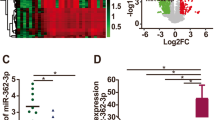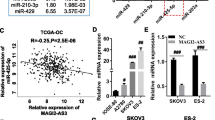Abstract
Ovarian cancer (OC) represents the most lethal form of gynaecologic cancers in developed countries. To develop a better therapeutic against OC, characterizing new classes of molecular regulators such as microRNAs (miRNAs) involved in OC tumorigenesis becomes immensely important. We used human OC cell lines to study the expression pattern of miRNA-205-3p. We then employed miRNA-205-3p mimic and inhibitor to elucidate its functional role in OC cells. Downstream target of miRNA-205-3p was characterized in OC cells with luciferase gene reporter assay and Western blotting. Its functional role in OC was also investigated with the siRNA approach. Lastly, we assessed the expression change of miRNA-205-3p and its newly identified target in human OC tissues. miR-205-3p was downregulated in five human OC lines tested. Over-expressing miR-205-3p reduced OC cell proliferation and migration. MAPK10 was identified as a direct target of miR-205-3p. Knocking down MAPK10 suppressed OC cell growth and migration. In contrast, knocking down miR-205-3p promoted clonogenicity of primary ovary cells. In clinical samples, miR-205-3p and MAPK10 expressed inversely in accordance with their expression patterns in OC cells. miR-205-3p was shown as a novel tumor suppressor in OC via inhibiting the MAPK10 pathway. This new finding may inspire new personalized treatment for OC.






Similar content being viewed by others
References
La Vecchia C. Epidemiology of ovarian cancer: a summary review. Eur J Cancer Prev. 2001;10:125–9.
La Vecchia C. Ovarian cancer: epidemiology and risk factors. Eur J Cancer Prev. 2017;26:55–62.
Bast RC Jr, Hennessy B, Mills GB. The biology of ovarian cancer: new opportunities for translation. Nat Rev Cancer. 2009;9:415–28.
Cannistra SA. Cancer of the ovary. N Engl J Med. 2004;351:2519–29.
Lux MP, Fasching PA, Beckmann MW. Hereditary breast and ovarian cancer: review and future perspectives. J Mol Med (Berl). 2006;84:16–28.
Romero I, Bast RC Jr. Minireview: human ovarian cancer: biology, current management, and paths to personalizing therapy. Endocrinology. 2012;153:1593–602.
Rupaimoole R, Slack FJ. MicroRNA therapeutics: towards a new era for the management of cancer and other diseases. Nat Rev Drug Discov. 2017;16:203–22.
Iorio MV, Visone R, Di Leva G, et al. MicroRNA signatures in human ovarian cancer. Cancer Res. 2007;67:8699–707.
Taylor DD, Gercel-Taylor C. MicroRNA signatures of tumor-derived exosomes as diagnostic biomarkers of ovarian cancer. Gynecol Oncol. 2008;110:13–21.
Kozomara A, Griffiths-Jones S. miRBase: annotating high confidence microRNAs using deep sequencing data. Nucleic Acids Res. 2014;42:D68–73.
Bogoyevitch MA, Boehm I, Oakley A, et al. Targeting the JNK MAPK cascade for inhibition: basic science and therapeutic potential. Biochim Biophys Acta. 1697;2004:89–101.
Kinose Y, Sawada K, Nakamura K, et al. The role of microRNAs in ovarian cancer. Biomed Res Int. 2014;2014:249393.
Nam EJ, Yoon H, Kim SW, et al. MicroRNA expression profiles in serous ovarian carcinoma. Clin Cancer Res. 2008;14:2690–5.
Wyman SK, Parkin RK, Mitchell PS, et al. Repertoire of microRNAs in epithelial ovarian cancer as determined by next generation sequencing of small RNA cDNA libraries. PLoS One. 2009;4:e5311.
Yang H, Kong W, He L, et al. MicroRNA expression profiling in human ovarian cancer: miR-214 induces cell survival and cisplatin resistance by targeting PTEN. Cancer Res. 2008;68:425–33.
Samuel P, Pink RC, Caley DP, et al. Over-expression of miR-31 or loss of KCNMA1 leads to increased cisplatin resistance in ovarian cancer cells. Tumour Biol. 2016;37:2565–73.
Qin AY, Zhang XW, Liu L, et al. MiR-205 in cancer: an angel or a devil? Eur J Cell Biol. 2013;92:54–60.
Wu H, Zhu S, Mo YY. Suppression of cell growth and invasion by miR-205 in breast cancer. Cell Res. 2009;19:439–48.
Xie H, Zhao Y, Caramuta S, et al. miR-205 expression promotes cell proliferation and migration of human cervical cancer cells. PLoS One. 2012;7:e46990.
Andaur R, Tapia JC, Moreno J, et al. Differential miRNA expression profiling reveals miR-205-3p to be a potential radiosensitizer for low- dose ionizing radiation in DLD-1 cells. Oncotarget. 2018;9:26387–405.
Jiang M, Zhang P, Hu G, et al. Relative expressions of miR-205-5p, miR-205-3p, and miR-21 in tissues and serum of non-small cell lung cancer patients. Mol Cell Biochem. 2013;383:67–75.
Mabuchi S, Altomare DA, Connolly DC, et al. RAD001 (everolimus) delays tumor onset and progression in a transgenic mouse model of ovarian cancer. Cancer Res. 2007;67:2408–13.
Kumar A, Singh UK, Kini SG, et al. JNK pathway signaling: a novel and smarter therapeutic targets for various biological diseases. Future Med Chem. 2015;7:2065–86.
Dai F, Zhang Y, Chen Y. Involvement of miR-29b signaling in the sensitivity to chemotherapy in patients with ovarian carcinoma. Hum Pathol. 2014;45:1285–93.
Yang X, Xiang X, Xia M, et al. Inhibition of JNK3 promotes apoptosis induced by BH3 mimetic S1 in chemoresistant human ovarian cancer cells. Anat Rec (Hoboken). 2015;298:386–95.
Gao S, Jin L, Liu G, et al. Overexpression of RASD1 inhibits glioma cell migration/invasion and inactivates the AKT/mTOR signaling pathway. Sci Rep. 2017;7:3202.
Bubici C, Papa S. JNK signalling in cancer: in need of new, smarter therapeutic targets. Br J Pharmacol. 2014;171:24–37.
Author information
Authors and Affiliations
Corresponding author
Ethics declarations
Clinical evaluation of miR-205-3p and MAPK10 gene expression in human OC tissues was approved by hospital ethical committee (#HZMH-076-jk). A total of 20 cancer patients were enrolled and the informed consent was obtained.
Conflict of Interest
The authors declare that they have no conflict of interest.
Additional information
Publisher’s note
Springer Nature remains neutral with regard to jurisdictional claims in published maps and institutional affiliations.
Electronic supplementary material
ESM 1
(DOCX 600 kb)
Rights and permissions
About this article
Cite this article
Qiao, B., Wang, Q., Zhao, Y. et al. miR-205-3p Functions as a Tumor Suppressor in Ovarian Carcinoma. Reprod. Sci. 27, 380–388 (2020). https://doi.org/10.1007/s43032-019-00047-y
Received:
Accepted:
Published:
Issue Date:
DOI: https://doi.org/10.1007/s43032-019-00047-y




